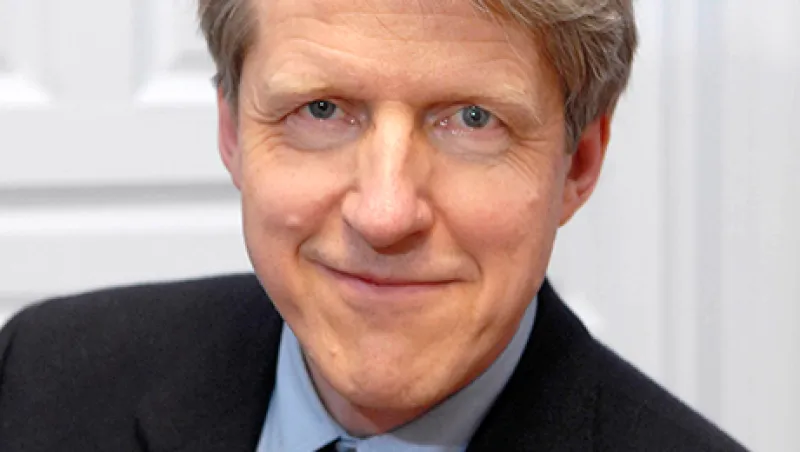A bond manager and an academic have joined forces to create one of the top-performing large-cap value equity funds of 2014. The tie-up between DoubleLine, founded in 2009 by former TCW Group CIO Jeffrey Gundlach, and Yale University economics professor Robert Shiller on the DoubleLine Shiller Enhanced CAPE fund shows how the asset management industry is battling investor disillusionment with active managers by introducing so-called smart beta products. It also reveals how one firm is trying to avoid common behavioral mistakes by programming rules into quantitative algorithms to build portfolios.
Smart beta funds use quantitative techniques to gain exposure to factors such as momentum or value. By contrast, index funds have historically offered exposure to some stand-in for the market in its entirety, such as the S&P 500 index, or parts of it.
Shiller won the 2013 Nobel Memorial Prize in Economic Sciences along with University of Chicago professors Eugene Fama and Lars Peter Hansen. The Nobel committee recognized Shiller for his work finding that security prices are more volatile than their intrinsic worth would lead investors to believe. But he’s perhaps more famous for warning that the stock market was overvalued in his 2000 book Irrational Exuberance, whose third edition appears in February.
The DoubleLine fund uses the Shiller Barclays CAPE US Sector TR USD Index, which Barclays developed to implement Shiller’s philosophy in the large-cap value equity sector. Shiller designed the CAPE (cyclically adjusted price-earnings) ratio to determine if the market is overvalued or undervalued. Analyzing the S&P 500 from 1871 to the current day, he established that his ratio is more valuable than the common, one-year price-earnings ratio because it uses ten years of earnings-per-share data. The DoubleLine fund has done well during its short life, landing in the top 1 percent of performers in Morningstar’s large-cap value category. In the 12 months after it launched in October 2013, it posted a 19.72 percent return.
Jeffrey Sherman, portfolio manager of macro asset allocation at $60 billion DoubleLine, one of the fastest-growing mutual fund firms ever, says the partnership makes sense in ways that aren’t immediately obvious. DoubleLine’s investment team, based at the firm’s Los Angeles headquarters, has used a value approach — not generally associated with bond pickers — for a couple of decades to identify fixed-income securities. Shiller has long studied behavioral finance and asset pricing, highlighting investors’ errors that lead to underpriced or value stocks.
DoubleLine constructs the fund’s portfolio to maximize the use of capital: Every dollar is invested so that it gets a dollar of exposure to the Shiller Barclays index, using a swap, and a dollar of exposure to an actively managed bond portfolio. The bond portfolio seeks to throw off 2.5 to 3 percent over cash in part to offset the inevitable downturns associated with any value strategy. “The problem with value is that it doesn’t work every year,” Shiller stresses. “But you can’t think like the herd and be successful in investing.”
DoubleLine is pairing its core expertise in bonds — finding anomalies in the fixed-income markets — with Shiller’s decades of work on asset pricing. Sherman says the fund offers investors different sources of return; he calls the bond portfolio a source of smart alpha: “While you’re waiting for your smart beta to kick in, you can grind out incremental return with low-risk fixed-income securities.”
With investors having pulled more than $60 billion from active U.S. equity funds as of October and plowed $131 billion into their cheap indexed cousins, according to Morningstar, active managers are rushing to offer smart beta funds. These funds are transparent and predictable but still try to outperform the market; as a result, they charge more than generic index funds.
Michael Hunstad, director of quantitative research at Northern Trust Asset Management in Chicago, says investors naturally want excess returns that don’t dwindle over time, which seems to be the case with active managers. “There’s a lot of research to suggest that factor-based strategies, smart beta strategies, if you will, have the potential to have persistence in their alpha,” Hunstad explains, “without this mean reversion that seems to happen with a lot of fundamental managers.”
The Shiller Barclays index is showing that the four most overvalued sectors are real estate, consumer discretionary, utilities and materials. DoubleLine’s Sherman says the utilities sector has gotten stretched because investors are using its stocks, which pay good dividends, as a proxy for bonds, whose yields are at historic lows.
Shiller laughs, adding that utilities were also overpriced in 1929, though for a very different reason. “Then it was a story of modernization and electrifying the nation,” he says. “Large electric companies were changing life, a little like an app today. You could listen to a radio show and the announcers would say, ‘Call now.’”
But “people overreact to a story, prices go up, and it’s a feedback loop,” Shiller says. “It can’t go on forever.” • •
Follow Julie Segal on Twitter at @julie_segal.







